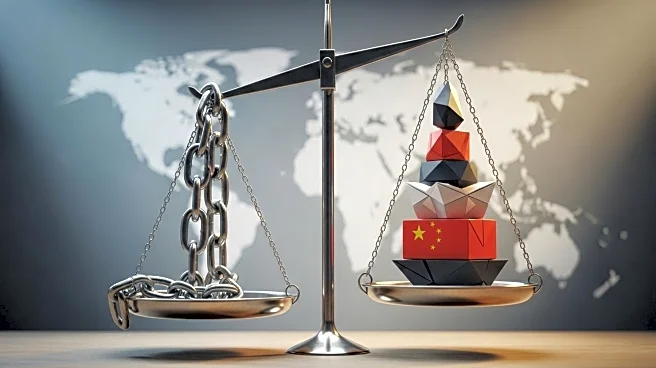What's Happening?
The Trump administration has enacted new tariffs on imported furniture, kitchen cabinets, and other housewares, as well as lumber, effective Tuesday. These tariffs, ranging from 10% to 50%, are part of
President Trump's strategy to prevent foreign products from overwhelming the U.S. market. The administration argues that these measures are necessary to protect national security and the domestic manufacturing process. While officials claim that the tariffs are primarily paid by overseas exporters, economists suggest that American consumers and businesses will bear a significant portion of the costs. According to a Goldman Sachs analysis, consumers could absorb about 55% of the added costs, U.S. businesses 22%, and foreign exporters 18%. The International Monetary Fund has noted that the tariffs have been less disruptive than initially expected, but the full impact remains uncertain.
Why It's Important?
The implementation of these tariffs is significant as it directly affects consumer prices and the U.S. economy. Higher costs for imported goods could lead to increased prices for consumers, particularly those involved in home building or remodeling. Inflation data indicates a rise in prices for furniture and household items, which could strain consumer budgets. On the other hand, the tariffs are intended to boost American manufacturing by encouraging companies to expand domestically. This could lead to job creation and increased federal revenue. However, the transition period may pose challenges for businesses and consumers as they adjust to the new economic landscape.
What's Next?
As the tariffs take effect, companies may continue to adjust their supply chains, potentially increasing domestic production. This shift could lead to long-term changes in the manufacturing sector, with more businesses choosing to onshore their operations. The administration's stance suggests that while there may be short-term costs, the long-term benefits could include a more robust domestic economy. Stakeholders, including businesses and consumers, will need to monitor the evolving situation and adapt to the changing market conditions.
Beyond the Headlines
The broader implications of these tariffs could include shifts in global trade dynamics, as countries respond to U.S. trade policies. There may be ethical considerations regarding the impact on foreign exporters and the potential for trade disputes. Additionally, cultural shifts could occur as consumers adjust their purchasing habits in response to higher prices for imported goods. The long-term effects on international relations and economic policies remain to be seen.












